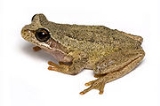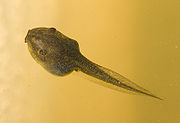
Brown Tree Frog
Encyclopedia

Victoria (Australia)
Victoria is the second most populous state in Australia. Geographically the smallest mainland state, Victoria is bordered by New South Wales, South Australia, and Tasmania on Boundary Islet to the north, west and south respectively....
, eastern South Australia
South Australia
South Australia is a state of Australia in the southern central part of the country. It covers some of the most arid parts of the continent; with a total land area of , it is the fourth largest of Australia's six states and two territories.South Australia shares borders with all of the mainland...
, southern New South Wales
New South Wales
New South Wales is a state of :Australia, located in the east of the country. It is bordered by Queensland, Victoria and South Australia to the north, south and west respectively. To the east, the state is bordered by the Tasman Sea, which forms part of the Pacific Ocean. New South Wales...
— from about Ulladulla , though there are reports of this species occurring further north — throughout Tasmania
Tasmania
Tasmania is an Australian island and state. It is south of the continent, separated by Bass Strait. The state includes the island of Tasmania—the 26th largest island in the world—and the surrounding islands. The state has a population of 507,626 , of whom almost half reside in the greater Hobart...
, including Bass Strait Islands, where it is the most frequently encountered frog in that state. It has been introduced to New Zealand
New Zealand
New Zealand is an island country in the south-western Pacific Ocean comprising two main landmasses and numerous smaller islands. The country is situated some east of Australia across the Tasman Sea, and roughly south of the Pacific island nations of New Caledonia, Fiji, and Tonga...
, where it can be locally abundant.
Physical description
This species reaches 45 mm in length. It is pale to dark brown on the dorsal surface, with a broad darker patch starting at the eyes and covering the majority of the back. There is a dark band starting at the nostril which runs through the eye and tympanum to the shoulder, and there is a pale white stripe below this which runs from the mouth to the arm. The back of the thighs are red, there is no black marbling present (except specimens from the Adelaide region), distinguishing this species from the similar Verreaux's Tree Frog, (Litoria verreauxii). Some specimens from western Victoria and south eastern South Australia can be partially or entirely green. The belly is cream.Ecology and behaviour
This species is found in a wide range of habitats. This includes forest, farmland, heathland, semi-arid areas, alpine regions and suburban areas. They are particularly common in parts of suburban Adelaide, Melbourne and Hobart, where they are often observed upon window panes at night, attracted by flying insects. Males make a whistling weep-weep-weep call from beside or floating in the water of, dams, ditches, ponds and streamside pools. Males call all year round, particularly after rain. Eggs are easily identifiable, being wound around submerged grass stems, aquatic vegetation and sticks.Amazingly, these frogs can freeze and survive

